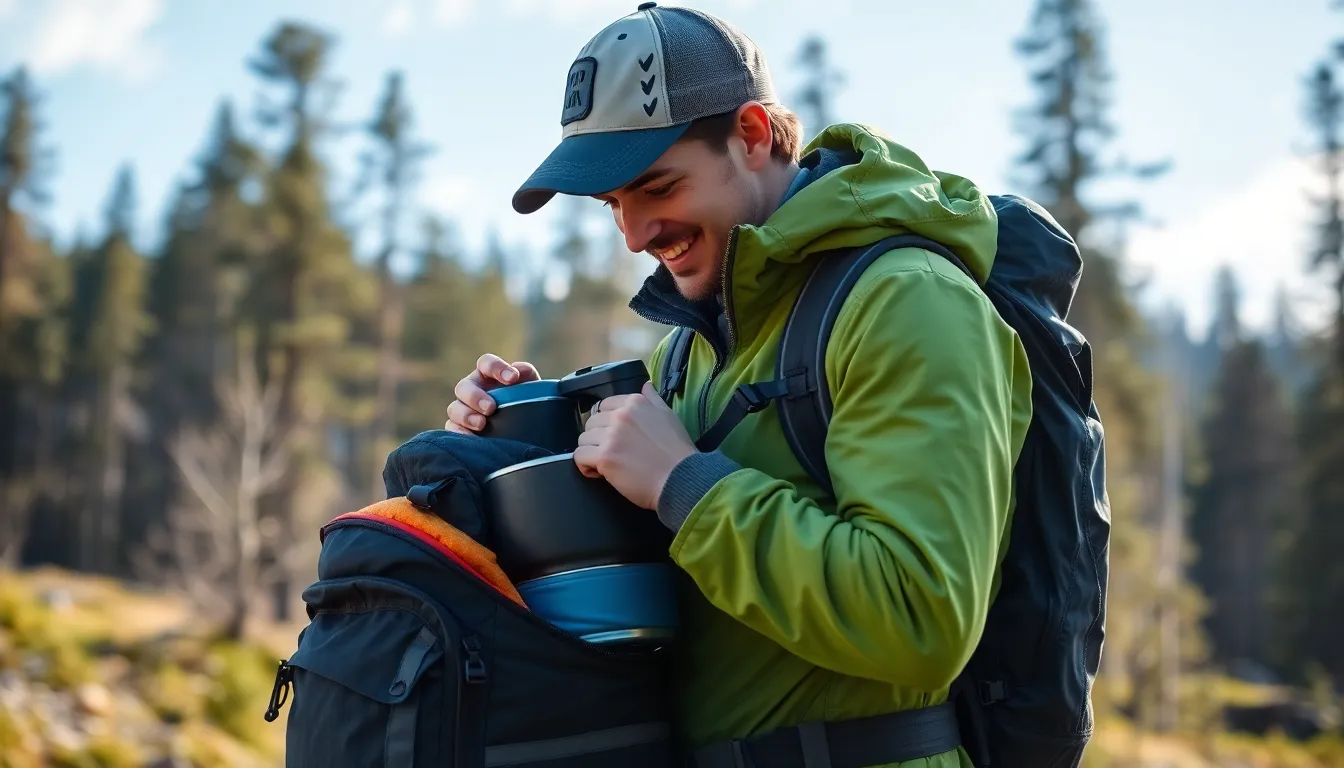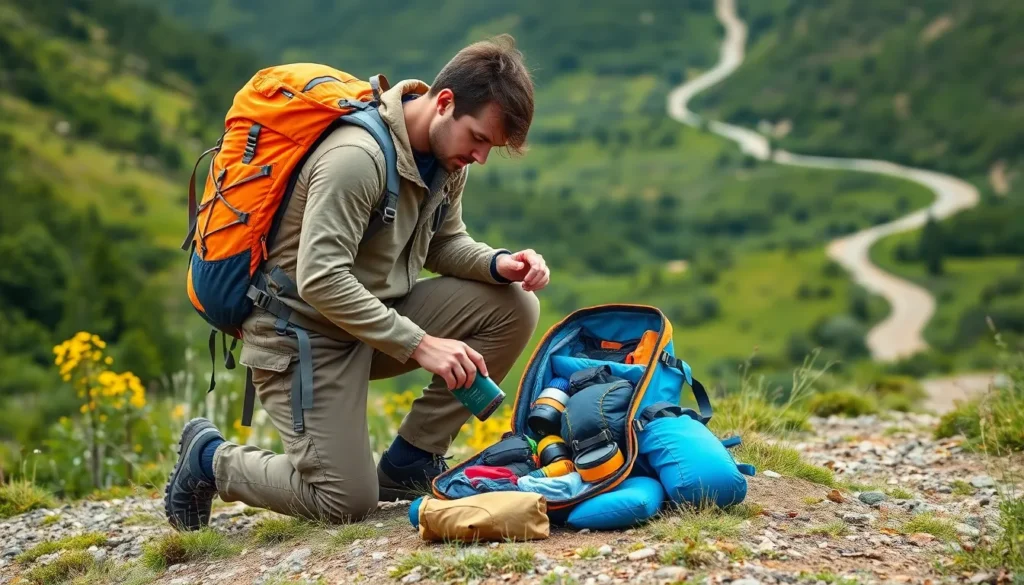Table of Contents
ToggleBackpacking is an adventure like no other, but packing the perfect backpack can feel like solving a Rubik’s Cube blindfolded. With the right techniques, he can transform that chaotic pile of gear into a well-organized treasure trove. Imagine hitting the trail with a pack that feels lighter than your last grocery run, all while knowing you’ve got everything you need for the journey ahead.
Understanding Your Backpacking Pack
Understanding backpacking packs enhances packing efficiency significantly. Various types cater to diverse needs and preferences, and several features play critical roles in usability.
Types of Backpacking Packs
Daypacks suit short trips, generally offering 15 to 30 liters of capacity. Weekend packs typically hold 30 to 50 liters, ideal for multi-day excursions. For extended journeys, full-size packs range from 50 to 80 liters, accommodating all necessary gear. Specialized options exist, such as hydration packs, designed for quick access to water. Different weight classes further aid in selecting the right pack, influencing comfort and performance based on the trip length and terrain.
Features to Consider
Weight influences overall comfort, so it’s essential to choose a lightweight design. Frame types vary, with internal frames providing structure and stability while external frames enhance ventilation. Consider adjustable straps for a snug fit, ensuring maximum security during movement. Pockets and compartments aid in organization, helping keep gear accessible. Weather resistance protects items from moisture, while ventilation features minimize sweat buildup. Ultimately, understanding these features allows for a tailored choice that meets specific backpacking needs.
Packing Essentials

Packing efficiently requires careful consideration of gear and weight distribution. Prioritizing essential items ensures a smoother backpacking experience.
Choosing the Right Gear
Selecting appropriate gear enhances comfort and functionality. Heavier items, such as tents and sleeping bags, should be reliable yet lightweight. Compact cooking gear serves a similar purpose, maximizing space while minimizing weight. Choosing multi-use items can save space; a Swiss Army knife combines various tools in one compact design. Waterproof and breathable clothing offers protection from the elements. Selecting quality gear tailored to specific trip lengths, like day hikes or multi-day treks, enhances overall experience.
Importance of Weight Distribution
Weight distribution directly affects balance and comfort while hiking. Placing heavier items, such as food and water, near the pack’s center lowers the center of gravity. Fitting lighter gear, such as sleeping bags and clothing, toward the top enhances stability. Using external pockets for frequently accessed items, like water bottles, promotes ease during breaks. Adjusting the load for individual body shapes can significantly improve comfort levels. Understanding these principles ensures efficient packing, resulting in a less strenuous journey.
Step-by-Step Packing Process
Packing a backpack efficiently requires a systematic approach. It’s vital to organize gear well and use effective packing techniques for comfort.
Organizing Your Gear
Begin by sorting gear into categories. Group items typically needed for cooking, sleeping, and clothing together. Place lightweight and bulky items like sleeping bags and tents at the bottom. Keep essential gear for easy access at the top or in external pockets. Consider using packing cubes to minimize space and streamline organization. Designate specific compartments for items such as toiletries and first aid, ensuring they’re easy to find. This method reduces time spent rummaging through the backpack during the trip.
Packing Technique Tips
Prioritize heavier items by placing them close to the back panel of the pack. Distribute weight evenly to maintain balance, allowing for comfortable movement. Position smaller items like snacks in outer pockets for quick access. Roll clothing to save space and reduce wrinkles. Compress and secure all gear tightly to maximize space and minimize shifting during travel. Utilize all available compartments; this ensures every inch of the pack is utilized effectively. Adjust the straps for a snug fit, optimizing comfort and stability while on the trail.
Final Adjustments
Adjusting a backpack correctly enhances comfort and stability on the trail. Proper adjustments can significantly impact the hiking experience, making every step feel easier.
Properly Fitting Your Pack
Fit your pack to avoid discomfort and improve weight distribution. Start by loosening all straps, then put the pack on. Adjust the shoulder straps first to ensure they sit comfortably on the shoulders without pinching. Next, tighten the hip belt so it rests above the hip bones for better support. Ensure the load lifters are at a 45-degree angle, pulling the pack closer to the body. Finally, check the sternum strap; it should cross the chest comfortably, allowing for free movement of the arms. This method ensures the weight transfers to the hips, reducing strain on the back.
Safety Tips for Hiking
Hiking safety encompasses several important practices. First, check the weather forecast before heading out; conditions can change rapidly. Carry essential items such as a map, compass, and first-aid kit to prepare for emergencies. Additionally, stay hydrated throughout the hike; bring enough water and a method to purify natural sources. Keep group sizes small to manage safety effectively, and let someone know your route and expected return time. Dress in layers to adapt to temperature changes, and choose sturdy footwear for grip and protection. Following these tips fosters a safe and enjoyable hiking experience.
Packing a backpack for an adventure doesn’t have to be daunting. With the right techniques and a systematic approach, anyone can master the art of packing efficiently. Prioritizing comfort and weight distribution is key to ensuring a smooth journey.
By understanding the various types of packs and their features, hikers can select the best option for their needs. Utilizing packing cubes and multi-use items can further enhance organization and save space.
Ultimately, a well-packed backpack not only lightens the load but also enhances the overall hiking experience, allowing adventurers to focus on the beauty of nature rather than the burden of their gear.




